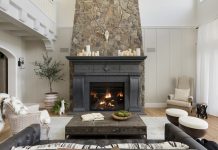The clients wanted it all: The decorative charms and distinctive character of a vintage Midwestern bungalow along with the comforts and convenience that define contemporary living. It was architect Paul Hannan’s job to puzzle it together on an urban lot near Lake Nokomis in south Minneapolis—and to make it happen on a limited budget.Hannan, a principal with SALA Architects in Minneapolis, has long been intrigued by the idea of creating affordable architecture for middle-class homeowners. Too often, he says, people who admire good design believe that architects are expensive—an extravagance they can’t afford when it comes to building a new home.

So Hannan produced a 1,590-square-foot home that minimized little-used spaces like hallways and foyers, and maximized the kitchen and living areas where the homeowners intended to spend most of their time. Through collaboration and communication with his clients and the contractor, the architect managed to integrate rift-cut white-oak cabinetry and white-oak flooring while staying on budget. Done smartly, design can create solutions and reduce costs simultaneously. “I want people to say they can’t afford not to hire an architect,” Hannan says.
So what’s required to get great residential design on a limited budget? We asked local architects and builders to reveal the lessons they’ve learned about building great homes for demanding clients with big dreams but limited means.

Know Your Budget
What’s affordable? That answer varies widely, among both clients and architects. The bungalow and garage that Hannan designed in south Minneapolis, for example, cost just under $400,000. To some, anything above $250,000 stretches the definition of affordable.
That’s why Sarah Susanka, author of The Not So Big House book series, encourages clients not to shy away from talking about money. “Too often, people have dreams in one hand and dollars in the other,” she says. “But they don’t want to talk about money until the design process is done. That’s a mistake.”
Discuss Your Priorities
Of course you can’t have everything. But knowing what’s non-negotiable before you enter the design process will make the process more efficient. Custom-home builder David Erotas of Excelsior-based Ethos Building recalls a budget-conscious client who really wanted a high-end Wolf stove in her kitchen. Finding good quality but low-cost solutions in other design elements ultimately allowed the builder to deliver the client’s dream.
The client’s flexibility in other regards helped keep costs in line. “In order to achieve budgets, there needs to be give and take,” Erotas says. “You can’t have everything you want. You have to prioritize.”
To develop a list of priorities, think about how you spend your time at home: Do you cook, entertain, have hobbies, or just relax? “We believe in focusing your energy and money on the things that are important to you,” says Ben Awes, an architect with CityDeskStudio in Minneapolis. To a degree, your home’s layout should resemble a map of your values and interests.
Tailor Your Space
It often pays to confer with a pro with an eye for flow and space planning. “Oftentimes people come to us and say, ‘We need more space,’” observes Geoffrey Warner of Alchemy Architects in St. Paul. “But we look around at what they have, and we usually end up telling them, ‘You don’t need more space. You just need different space.’”
When unused spaces like separate wine cellars, home offices, and even hallways are pared away, the result is often a smaller footprint, which reduces overall building costs. “People don’t want monster houses,” Warner says. “They want houses that feel spacious and are open and filled with light.” Those effects are the result of good design—a small house can still feel large and accommodating.






Interview Contractors Early
Typically, architects provide complete detailed construction documents to clients, who then send them to builders, asking for bids. But Hannan and others say budget-minded clients sometimes are better served by drawing contractors into the conversation early on. “They come on as a team member and help make decisions all the way through,” Hannan says. The results can be win-win-win: Small structural changes, for example, can lessen costs significantly without impacting aesthetics.
Hannan often sketches out the rough parameters of a project then, with his clients in tow, approaches several contractors and asks if they can meet the expected budget. For the Nokomis house, not everyone was confident they could deliver the goods and hit the bottom line, too. Fortunately, Ethos responded with enthusiasm about the scope and size of the challenge. “The project wasn’t going to go forward if we couldn’t hit this budget range,” Hannan says. In the end, Ethos delivered value by sniffing out sources for high-end materials—like real cedar shingles—at the best prices.
Modify Material Choices
High-grade materials like quarter-sawn oak and marble countertops can add luster and luxe to a design. But just because you saw some wood, stone, or metal in a shelter magazine doesn’t mean it’s the only solution for you.
Budget-minded architects and contractors search out substitutions that often cost less while adding unique quality. “If your ideal is soapstone but you can’t afford it, a laminate may be a less expensive and perfectly fine solution,” says Hannan. The same goes for other finishes, says Erotas: “People think second-grade wood flooring is terrible. But, quite frankly, it often has more character, which can make it more pleasing.”
Bottom lines also are often easier to meet if you mix in some prefab materials. Awes recently finished a new 3,500-square-foot home in Roseville for a client who insisted on custom cabinetry. But an exploratory trip to Lowe’s resulted in fresh thinking: The client found high-quality prefabricated cabinets that met his high standards but cost considerably less than custom creations.

Consider Some DIY
Paying an architect to sort through and suggest featured design elements—like a fancy sink or chandelier—can be costly. Some architects, like Warner, encourage their clients to search out—and even make—such items themselves, reserving their dollars to pay architects for design rather than sourcing.
Antiques, mechanical equipment, and reused items also can lend character to a design. “I think the thriftiness and joy of finding things and reusing them—for example, making a chandelier from a bedspring or covering a wall in freeway signs—bring character that you can only get through reuse.” Warner says. ”It’s not necessarily a lot cheaper if I’m fabricating it. But if the owner is fabricating it, it’s essentially free. And either way, it’s unique.”
Turn Your Site Inside Out
Basements are often left unfinished and considered wasted space until they can be transformed into something more. But creative thinking led Christian Dean of the eponymous Minneapolis architecture firm to create walkout areas on sloped sites in Golden Valley and Chanhassen, turning dark dungeons into illuminated, usable spaces. “The lower level wasn’t just for storage anymore,” Dean says. “Now it was livable.”
Likewise, larger windows with good sightlines make living spaces seem more spacious. Sliding doors and screens can leverage outdoor living areas, adding seasonal space.
Stop Short of the Finish Line
Your budget needs to cover all the structural costs and most of the interior work. But when it comes to finishes, there’s nothing wrong with making choices to meet your bottom line, says Hannan: “You can do 90 percent now and plan to do the remaining 10 when you have more money.” Some design elements—like countertops— easily can be replaced with higher-end materials when you have the money in hand.
In the end, architects and builders say there’s a thrill in designing and building homes that meet the needs of everyday clients, delivering architectural flair and unique solutions to folks who appreciate them. “Meeting the budget is part of the fun of it,” says Erotas. “Everybody works together to make these smaller, affordable homes into architectural gems.”
And Hannan likes the satisfaction of delivering a dream that even the client didn’t fully imagine. “I like to design houses where a person will use all of the space,” he says, “rather than what they think they need.”





















